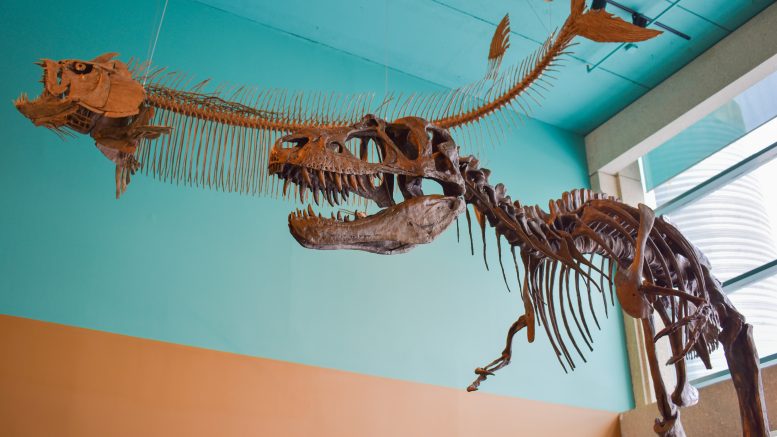About 65 million years after their extinction, dinosaurs remain some of the most famous prehistoric animals, and are often depicted in popular culture.
In the 1993 film Jurassic Park, the iconic Tyrannosaurus rex was portrayed with large teeth that stuck out of its mouth, even when shut.
Contrary to these depictions, an international collaboration that included U of M assistant professor in the department of earth sciences Kirstin Brink recently found that the prehistoric creatures had scaly lips covering their teeth.
The project began over 10 years ago, when Brink was a graduate student at the University of Toronto. Brink and her colleagues were curious about the accuracy of dinosaur representations in media.
“This idea was popularized that the teeth of T. rex were too big to fit in the mouth when they were closed,” she said.
The T. rex had sharp, serrated edges along their teeth, which helped it slice through the food it consumed.
Brink explained that the group decided to compare measurements of dinosaur teeth with extant species that had extremely long teeth to see if it would have been possible for a T. rex to have had a scaly lip. The team made comparisons between the teeth structure in the T. rex and the Komodo dragon, the largest extant lizard.
Komodo dragons have long teeth relative to their skull — even longer proportionally than that of a T. rex. Despite this length, these reptiles are able to have scaly lips that cover their teeth.
“It’s not weird to think that T. rex or other big meat-eating dinosaurs would have also had scaly lips covering their teeth,” Brink said.
Additionally, the team analyzed the quality of teeth in dinosaurs and their closest living relatives, crocodiles.
The upper and lower teeth of a crocodile interlock and protrude when its mouth is closed. As a result, its teeth lack protective covering and are often worn down or damaged.
In contrast, dinosaurs like T. rex often have well-preserved teeth. Brink explained that the only way dinosaurs could have maintained their teeth in such good shape was through lip protection.
Overall, this evidence shows that the extinct species looked more similar to modern Komodo dragons than crocodiles.
Brink is curious to see if these findings will translate into the media and film industry’s depictions of dinosaurs.
“People think they’ll look scarier if you can see the teeth,” Brink said, “but really we’re using biological data looking at living animals, looking at actual measurements from these fossils to say, ‘actually, these are real animals and they had a mouth that looked like a lizard.’”
“They’re not some big scary movie monster.”
During her PhD, Brink looked at the evolutionary patterns of Dimetrodon teeth. These are prehistoric reptiles related to primitive mammals.
Now at the U of M paleontology lab, Brink and her graduate students continue to work on teeth development, pathologies, abnormalities and fossils found here in Manitoba.
One of her students is currently working on teeth in extinct marine reptiles called Mosasaurs, trying to determine whether or not they were migrating in the oceans. Additionally, students volunteer in the lab for tasks such as fossil preparation.
To Brink, paleontology and the study of fossils offer perspective on how life and the earth has evolved over time.
She noted how, through the analysis of teeth alone, one can uncover geochemical information and gain an insight into the diet of these extinct species.
“I think there’s just so much information we can learn about how the planet has changed,” she said.


